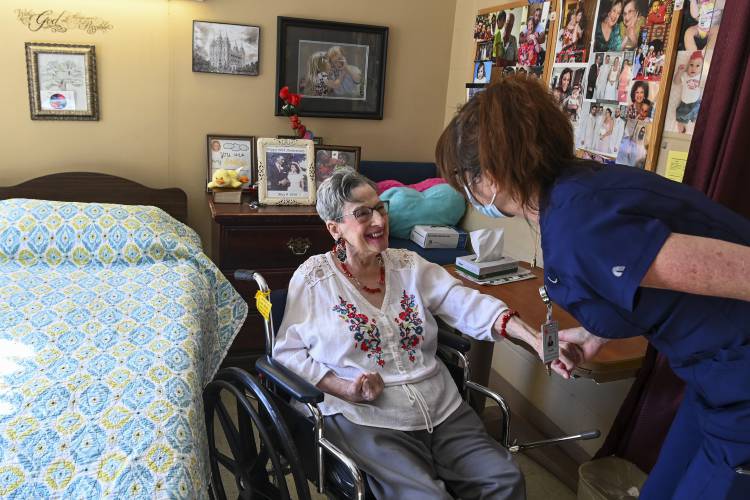Opinion: Long term care: Medicare vs. Medicaid

Resident Eleanor Garrison, left, talks with director of nursing Cheri Place-Chafin in her room Wednesday, Feb. 3, 2021, at Arbor Springs Health and Rehabilitation Center in Opelika, Ala. Julie Bennett/ AP
| Published: 02-16-2024 6:00 AM |
Richard Moore lives in Chichester.
A couple dozen of my middle-income baby boomer Medicare friends and I have been contemplating our potential Long Term Care (LTC) needs over the next few years. The middle-income Medicare LTC outlook appears bleak and potentially budget-breaking expensive.
If you are on Medicare and need long-term care help with basic personal tasks of everyday life, sometimes called “activities of daily living,” then you are 100% responsible for the entire LTC cost. This includes dressing, bathing and using the bathroom. Medicare does not cover these LTC services. If you hire an individual or a company to come to your house to provide these LTC services then you will be responsible for the entire cost. If you enter a LTC facility to receive these LTC benefits you will be responsible for the LTC cost.
It is extremely important to note that skilled nursing, rehab, and other medical services are not LTC and the non-LTC services may be “covered” by Medicare. There may even be some cases where limited LTC might be temporarily “covered” to some extent as a necessary related service to a skilled nursing, rehab, or similar Medicare covered benefits but standalone LTC is not covered by Medicare.
Long Term Care can cost the LTC patient thousands of dollars per month. Thousands of dollars a month is a tough hit to many middle-income budgets and many middle-income Medicare patients may not be able to afford the cost of LTC.
You may have seen newspaper articles, NH legislation, studies, and reports about LTC improvements and enhancements but that is for Medicaid LTC, not LTC for middle-income Medicare recipients. If you are on Medicare then you are on your own for LTC. The TV advertisements that show nice people coming into your home to help you don’t highlight that Medicare LTC patients are responsible for the LTC cost.
You may know of family and friends who have gone through the Medicaid “spend down” and the five-year look back to meet the strict financial requirements to be Medicaid eligible for LTC. This can be a very stressful and difficult financial, emotional, and dignity process for the patient and the patient’s family.
We suggest that the Medicare rules be changed to allow Medicare to “cover” LTC. The new rules would allow LTC “coverage” to begin when the appropriate advanced benefit notification (ABN) is issued per existing Medicare rules. The new Medicare LTC benefit would cease when the patient passes or the official hospice documentation is processed, again in accordance with existing Medicare processes.
Article continues after...
Yesterday's Most Read Articles
 Concord may finally buy long-closed rail line with hopes of creating city-spanning trail
Concord may finally buy long-closed rail line with hopes of creating city-spanning trail
 New Hampshire targets sexual exploitation and human trafficking inside massage parlors
New Hampshire targets sexual exploitation and human trafficking inside massage parlors
 State rules Epsom must pay open-enrollment tuition to other school districts, despite its refraining from the program
State rules Epsom must pay open-enrollment tuition to other school districts, despite its refraining from the program
 New Cheers owners honor restaurant’s original menu while building something fresh
New Cheers owners honor restaurant’s original menu while building something fresh
 Remembered: Friends recall stories about the lives of those who died without housing
Remembered: Friends recall stories about the lives of those who died without housing
 A look ahead at the ‘preferred design’ for Concord’s new police headquarters
A look ahead at the ‘preferred design’ for Concord’s new police headquarters
This My Turn has used the Medicare definition of LTC and identified the official beginning of LTC and the official end points of LTC. This is important to address the potential cost and benefits of a Medicare LTC benefit within these parameters. Many newspaper articles, studies, and reports do not clearly state their services addressed or the beginning and end points of LTC using existing Medicare parameters. Many other articles, NH legislation, studies, and reports treat Medicaid LTC as the entire LTC. Medicare LTC tends to be ignored and middle-income Medicare patients tend to be ignored for LTC “coverage.”
The current total annual costs of LTC provided to middle-income Medicare patients in NH is unknown. It seems reasonable to expect the current middle-income LTC cost to be more than the current total “private pay” to in-home LTC providers and to facility-based LTC providers. Estimating the amount that NH middle-income Medicare LTC patients pay annually will require cooperative teamwork between all parties involved.
What might LTC coverage look like and how would it be funded? A couple of initial steps include determining an appropriate Medicare pay rate for in-home LTC workers and also an appropriate Medicare rate for facility-based LTC. Then one option is to have Medicare “cover” in-home LTC up to some limit, maybe 70 hours per week. Medicare could pay for the in-home LTC at the usual 80% rate and the patient would be responsible for the other 20%, similar to many other Medicare coverages.
The funding for this new Medicare LTC benefit could come from a variety of sources including a modest increase to the current $175/month Medicare premium, a modest increase to the 1.45% Medicare payroll tax, an increase to the Medicare payroll tax cap, a redirection of some of the funds paid to Medicare Advantage programs, the Medicaid savings by creating Medicare LTC benefits, and other possible sources.
The “coverage” for facility-based LTC coverage tends to be significantly more expensive than in-home services and might be something for the Medigap Supplemental Insurances. The facility-based Medigap coverage might follow the model of the existing private LTC insurance or the Medigap Insurance companies may develop a new model. Hopefully, the Medigap LTC insurance would be able to serve a larger population than the private insurance options and be able to provide stable coverage at stable premiums.
In addition to providing financial and emotional benefits to the middle-income Medicare patients and their families, this new benefit would reduce the number of patients entering Medicaid LTC because the “spend down” would be deferred and possibly eliminated in some cases. This would reduce the number of people entering Medicaid LTC. The cost savings to Medicaid LTC needs to be estimated.
There are several benefits to creating Medicare LTC benefits. Please contact your federal Congressional Reps. Kuster and Pappas and Sens. Shaheen and Hassan to encourage them to support a new Medicare LTC benefit.







 Opinion: Trumpism in a dying democracy
Opinion: Trumpism in a dying democracy Opinion: What Coolidge’s century-old decision can teach us today
Opinion: What Coolidge’s century-old decision can teach us today Opinion: The art of diplomacy
Opinion: The art of diplomacy Opinion: After Roe: Three years of resistance, care and community
Opinion: After Roe: Three years of resistance, care and community
